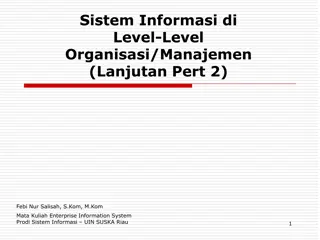Measuring Performance to Support Systems Integration by Dr. Nick Goodwin
Dr. Nick Goodwin, CEO of the International Foundation for Integrated Care, discusses the challenges and importance of measuring performance to support systems integration in healthcare. The paper delves into the complexities of disintegrated care systems, highlighting the need for a patient-centered approach to achieve successful integration.
Download Presentation

Please find below an Image/Link to download the presentation.
The content on the website is provided AS IS for your information and personal use only. It may not be sold, licensed, or shared on other websites without obtaining consent from the author.If you encounter any issues during the download, it is possible that the publisher has removed the file from their server.
You are allowed to download the files provided on this website for personal or commercial use, subject to the condition that they are used lawfully. All files are the property of their respective owners.
The content on the website is provided AS IS for your information and personal use only. It may not be sold, licensed, or shared on other websites without obtaining consent from the author.
E N D
Presentation Transcript
Home Measuring performance to support systems integration Dr Nick Goodwin CEO, International Foundation for Integrated Care Senior Associate, The King s Fund Paper to Challenging Ideas Seminar Series Health Performance Reporting Bureau of Health Information, Civil Pavilion, Chatswood Concourse 8 December 2014 www.integratedcarefoundation.org
International Foundation for Integrated Care Who are we? Mission Statement Our Purpose To develop a membership network that provides a central, authoritative, resource for information and expertise on integrated care To advance the study and science of integrated care To develop knowledge on the evidence for, and application of, successful approaches to integration To bring people together from a range of backgrounds to network and exchange ideas to promote integrated care The International Foundation for Integrated Care (IFIC) is a network that crosses organisational professional boundaries people together to advance the science, knowledge and adoption of integrated care policy and practice. and bring to The Foundation seeks to achieve this through the development exchange of ideas among academics, researchers, managers, policy makers and users and carers of services throughout the World. and clinicians, Home
A Typical Problem of Disintegrated Care Systems The complexity in the way care systems are designed leads to: lack of ownership of the person s problem; lack of involvement of users and carers in their own care; poor communication between partners in care; simultaneous duplication of tasks and gaps in care; treating one condition without recognising others; poor outcomes to person, carer and the system Frontier Economics (2012) Enablers and barriers to integrated care and implications for Monitor -
Integrated care is a concept centred around the needs of service users The patient s perspective is at the heart of any discussion about integrated care. Achieving integrated care requires those involved with planning and providing services to impose the patient s perspective as the organising principle of service delivery (Shaw et al, 2011, after Lloyd and Wait, 2005)
Who is integrated care for? Integrated care is an approach for any individuals where gaps in care, or poor care co-ordination, leads to an adverse impact on care experiences and care outcomes. Integrated care is best suited to frail older people, to those living with long-term chronic and mental health illnesses, and to those with medically complex needs or requiring urgent care. Integrated care should not be solely regarded as a response to managing medical problems, the principles extend to the wider definition of promoting health and wellbeing Integrated care is most effective when it is population-based and takes into account the holistic needs of patients. Disease-based approaches ultimately lead to new silos of care.
Integration and Integrated Care Integrationis the combination of processes, methods and tools that facilitate integrated care. Integrated careresults when the culmination of these processes directly benefits communities, patients or service users it is by definition patient-centred and population-oriented Integrated care may be judged successful if it contributes to better care experiences; improved care outcomes; delivered more cost-effectively Without integration at various levels [of health systems], all aspects of health care performance can suffer. Patients get lost, needed services fail to be delivered, or are delayed, quality and patient satisfaction decline, and the potential for cost-effectiveness diminishes. (Kodner and Spreeuwenburg, 2002, p2)
Key forms of integrated care Integrated care between health services, social services and other care providers (horizontal integration); Integrated care across primary, community, hospital and tertiary care services (vertical integration); Integrated care within one sector (e.g. within mental health services through multi-professional teams or networks); Integrated care between preventive and curative services; Integrated care between providers and patients to support shared decision making and self-management; Integrated care between public health, population-based and patient-centred approaches to health care. This is integrated care at its most ambitious since it focuses on the multiple needs of whole populations, not just to care groups or diseases Source: adapted from International Journal of Integrated Care
The promise of integrated care The hypothesis for integrated care is that it can contribute to meeting the Triple Aim goal in health systems Improving the user s care experience (e.g. satisfaction, confidence, trust) Improving the health of people and populations (e.g. morbidity, mortality, quality of life, reduced hospitalisations) Improving the cost-effectiveness of care systems (e.g. functional and technical efficiency)
Understanding what aspects of performance to evaluate in an integrated care programme
What are you evaluating some key questions Who and what is the programme seeking to influence? Need to clarify aim and design of the integrated care intervention by looking at the needs of patients/users What is the timeframe over which outcomes are expected to be achieved? Given this timeframe, which categories of outcomes have the potential to be improved? Is there sufficient opportunity in a given population to achieve this targeted improvement in outcomes? How can you measure the impact? How can you ensure attribution?
What are you evaluating some key questions Before developing questions and/or survey instruments to examine the experience and impact of integrated care from a person s perspective, there is a need to understand four things: the programme theory of change what are the assumptions that lie behind the programme (why?) the (set of) problems to be addressed (where and who?) the (set of) interventions best suited to address the problem (what and who?) the strategy best suited to develop, implement, and evaluate the (set of) interventions (how, when and who?)
What are you evaluating some key questions For integrated care to be successful, it needs to execute the following three functions: accurate identification of individuals within target population (e.g. reliable predictive modelling, health risk assessment, medication list and/or laboratory values from EMRs); individuals must be enrolled and actively participate in the program for a meaningful period of time (e.g. readiness to change, motivational interviewing, incentives); the program must include a set of interventions that modify or close deficits in participant and provider behaviour (e.g. tailoring to needs).
Key Points to Consider Baseline data Define a comparison group Define nature and structure of integrated care being implemented Include measures of the professionals perspective where care is delivered through multidisciplinary teams Identify what good looks like from a patients perspective and evaluate this through user feedback Include analysis of utilisation and costs of care Experiences, care outcomes, utilisation & costs
Choosing Quality Measures for Integrated Care- 1 Indicators must be robust and meaningful: Importance and relevance Validity Accuracy Reliability Feasibility Meaningfulness Implications for action Avoidance of perverse incentives
Choosing Quality Measures for Integrated Care - 2 Considerations: Population size Representativeness Attributable Change detectible over time Unambiguous Meaningful to who? users, managers, professionals, politicians Timeliness Routine data collection
Tin openers or dials Concept from Carter and Klein (e.g. 1992) Tin openers open up cans of worms Dials measure things Most of the time you need to ask the right questions as much as you need to get the right answers If you want to be making robust judgements, the measures need to be absolutely unambiguous
The dangers of performance measures Peter Smith identifies 8 perverse effects Unmeasured activity ignored Reward structure distortive(too easy, too hard, wrong balance) Discourages practice in challenging environments Discourages collaborative actions Gaming Misrepresentation Ossification Increases managerial costs Undermines professional ethic, morale and unremunerated activity
Why the dangers? Bevan and Hood identify four types of player Type Characteristics Saints public service ethos so high voluntarily disclose shortcomings, their agenda will be motivated by their intrinsic motivations external incentives don t work if these conflict Honest triers Report honestly what they have done, and will endeavour to improve in response to reported poor performance. Less likely than saints to have an internal drive for improvement, respond to external incentives Reactive gamers Like honest triers, gamers concentrate efforts on services which are being measured and incentivized. Unlike them their responses will not always be positive. If it is easier for them to give the appearance of doing well than actually doing well, will spin or fiddle data Rational maniacs Rational maniacs act entirely in self interest and respond to incentives in unpredictable ways. In some instances this group will be unethical, even criminal, in their behaviours. Will manipulate data to conceal their operations
The lessons for choosing performance measures Be very clear about what incentives you are using Think carefully about the perverse incentives and seek to limit these Fear of loss trumps everything (Kahneman) Payment systems really do matter If the existing reward is to be disintegrated, new incentives to be integrated won t work
International Drive to Develop Quality Measures for Integrated Care Policy reforms to support integrated care have also seen attention placed on how to develop a set of quality indicators through which to monitor system performance. For example: In New Zealand, the Integrated Performance and Incentive Framework was drafted in 2013 containing an inventory of measures intended to support District Health Boards identify and use locally relevant system- level measurements indicating progress towards care integration and improved health and equity for all population groups (HIIRF, 2013) In England, a range of generic indicators for measuring the quality of integrated care has also been developed. This includes 35 specific indicators across six key domains of quality (Raleigh et al, 2014). In the USA, NQF indicators relevant to patient-centered and integrated care include a range of endorsed measurements of patient centered care and care coordination (National Quality Forum, 2014), In the USA, The AHRQ have also created a framework through which to assess care co-ordination, including a range of measurement domains (McDonald et al, 2007)
Care Co-ordination Measures Atlas McDonald KM, Schultz E, Albin L, Pineda N, Lonhart J, Sundaram V, Smith-Spangler C, Brustrom J, and Malcolm E. Care Coordination Atlas Version 3 AHRQ Publication No.11-0023-EF. Rockville, MD: Agency for Healthcare Research and Quality. November 2010. http://www.ahrq.gov/qual/careatlas/careatlas.pdf and http://www.ahrq.gov/qual/careatlas/careap4.pdf - 64 different survey tools
Domains for measuring care co-ordination Co-ordination activity: Establish accountability/negotiate responsibility Communication informational and inter-personal Facilitate transitions e.g. across settings or as coordination needs change Assess multiple needs and goals Pro-active care planning Monitor, follow-up, review Support self-management Link or refer to community resources Align resources to meet individual or community needs Service delivery approaches: Care management Medicines management Healthcare at Home Multi-disciplinary teams ICT-enabled integrated care (e.g. telehealth) Perspectives: Family/patient Professional System/organisation
Key Domains and Indicators for Integrated Care System-level measures of community wellbeing and population health includingreductions in avoidable deaths for treatable conditions, improved mental health and wellbeing, and the proportion of populations engaged in healthy lifestyle behavior; Service proxies for improved health outcomes such as avoidable admissions to hospitals, lengths of hospital stay, and reductions in adverse events; Personal health outcomes to people and communities, primarily relating to measures of improved quality of life, remaining independent, and reducing risk factors to better manage existing health conditions;
Key Domains and Indicators for Integrated Care Resource utilization that seeks to describe measures which demonstrate the reorientation of activities towards primary and community care, for example in terms of the balance of financial and human resources; Organizational processes and characteristics that support evidence that systems to support high-quality PCIHS are in place, for example in improving access to care, care planning, better care transitions, self-care support, care management and medications reconciliation; User and carer experiences of, for example, shared decision-making, care planning, communication and information sharing, and care co-ordination.
Domain 1: System level Measures AREA EXAMPLES OF POTENTIAL MEASURES Amenable Mortality Numbers of avoidable deaths for treatable conditions, including: Infections; Cancers; Cardiovascular disease; Diabetes; Injuries; Maternal and infant conditions [B] Excess winter deaths [A] Excess mortality for people with severe mental illness and schizophrenia [D] Healthy Lifestyles Amenable morbidity (obesity) [B] Proportion of physically active and inactive adults [A], and children Proportion of the population experiencing positive mental health [B] Proportion of the population engaged in responsible sexual behavior [B] Proportion of the population engaged in substance misuse [B] Proportion of the population engaged in healthy behaviours (composite measure) [B] Smoking rates Smoking status; % of smokers given or referred to cessation support; % of hospitalized smokers provided with cessation advice; Smoking rates in people with asthma [B] Proportion of the population that experience injury [B], including self-harm Population Health Prevalence of mortality for chronic disease [B] Healthy births e.g. measured by low birth weight [B] Vaccination coverage For influenza in older people [B, D]; For measles in children [D]; For pertussis in children [D] Management of skin infections in primary care [B]
EXAMPLES OF POTENTIAL MEASURES AREA Domain 2: Service Proxies Numbers of emergency admissions, stratified by age and risk group [A] Avoidable inpatient activity for people with ambulatory condition sensitive (ACS) admissions ACS hospital admissions that could have been avoided in both children and adults [B]: Asthma in older adults [B]; Asthma in young children [B]; Asthma hospital admission rates [D] COPD in older adults [B]; COPD hospital admission rates [D] Heart failure admission rates [B, D]; Angina without procedure admission rates [B] Hypertension admission rates [B] Diabetes short-term and long-term complications admission rates [B]; Uncontrolled diabetes admission rates [B]; Overall diabetes admission rates [D] Bacterial pneumonia admission rates [B] UTI admission rates [B] Acute care hospitalization, risk adjusted [C]; Acute care hospitalization rate for ACS conditions [H] Average lengths of stay [B]; Occupied bed days [B] Hospital Admissions People with multiple admissions to hospital per year by specific age group; Readmission rates for selected patient groups [A] Diabetes readmission rate [B]; Heart failure readmission rate [B]; Mental health readmission rate [B] Unplanned or unexpected hospital readmissions [B] Emergency readmissions to hospital within 28 days of discharge [H] Overall numbers of hospital readmissions [D] Hospital Readmissions Persons discharged from hospital for rehabilitation per 100k of the older population [A] Deaths after discharge from suicide among people with severe mental disorders [D] Quality of family planning services: Informed choice to users Contraceptive methods mix offered in care facilities [H] Community Based Care Reduction in adverse events [B] Unintended harm from medications in people aged over 65 dispensed with five or more long-term medications [B] NSAID use in older people [B] Patient Safety
Domain 3: Personal Health Outcomes AREA EXAMPLES OF POTENTIAL MEASURES Quality of life Self-reported quality of life [A] Carer reported quality of life [A] Improved mental health status and mood Independent living Proportion of older people (>65) who remain in own home after 91 days after discharge from hospital into rehabilitation services [A] Injuries due to falls in people aged over 65 [A] Proportion of patients with fragility fractures recovering to their previous levels of mobility [A] Improved mobility and independence [EQ5D] Self Proportion of people feeling supported to manage their (long term) condition [A] People aged over 65 with more than 8 long-term conditions [B] Management of risk factors in chronic disease [QOF]: Blood glucose and cholesterol control in people with diabetes Blood pressure control in people with stroke, TIA, heart disease, CKD and hypertension Diet, nutrition and weight management in under- / over-weight management
Domain 4: Resource Utilization AREA EXAMPLES OF POTENTIAL MEASURES Hospital utilisation Bed days for selected patient types [A] Hospital use in last 100 days of life [A] ; in last 6 months of life [B] Residential and long term care utilisation Residential and nursing care expenditures per 100k older population Numbers receiving long-term community-based care as a proportion of total numbers of people receiving long-term care services [A] Numbers receiving long-term social care as a proportion of the sum of numbers receiving emergency hospital care and numbers receiving long term social care [A] Numbers of people receiving long-term community-based social care relative to population [A] Primary care utilisation Enrolment in a GP/primary care practice [B] for infants in the first 4 weeks of life [B] Health care costs Health care cost per capita [B] Rational use of finite resources / value for money and effectiveness [B] GP referred pharmaceutical expenditure [B] Alignment of resources to population needs [D] Balance of care Ratio of primary care professionals (e.g. GPs) to specialists Relative spend on primary, community, secondary and tertiary care
Domain 5: Organisational Processes 1 AREA EXAMPLES OF POTENTIAL MEASURES Access to care Improved access to primary care services / GPs [A] Access to health care [B] - % in general practice [B]; screening [B]; time to access GP or community services [B]; timely initiation of care [C]; waiting times for urgent treatment especially cancer [B]; severe mental health access [B]; waiting times for elective treatment [B]; waiting time of more than 4 weeks to see a specialist [E] Hospital use Attendances at A&E [A] Attendances at A&E without hospitalization [C] Acute care hospitalization [C] Care transitions Delayed transfers of care from hospital [A] Transition record with specified elements received (hospital to home or any other site of care) [C] Timeliness of transition (hospital to home or any other site of care) [C] Care planning Holistic needs assessment Personalized care plans Advanced care plan [C] Medications management Medication review in older adults [C] Medications reconciliation [C] Medications conciliation post-discharge [C]
Domain 5: Organisational Processes 2 Care co- ordination PHC organizations who currently coordinate patient care with other health care organizations using protocols [H]; Quality of care processes based on best practice guidelines look at integration of care across settings - chart reviews, medical records [D, F] Quality of clinical integration and/or co-ordination activities in multi- professional teams [F] various survey methods Administrative communication [C] percentage of patients transferred to another healthcare facility whose medical documentation indicated that administrative information was communicated prior to departure Presence of key co-ordination activities [D]: accountable provider or professional with responsibility for care coordination clarity of responsibility quality of inter-personal communication/ information transfer facilitate transfers across settings assess needs and goals with proactive care plans monitor, follow-up and respond to change support for self-management links to community resources provide information and guidance on care outside of health system multi-disciplinary teams in primary and community care home care support care management case management and disease management medications management ICT enabled care coordination (telehealth)
Domain 6: User and Carer Experiences - 1 AREA EXAMPLES OF POTENTIAL MEASURES Experiences Improved people s experiences of care [A, B] Patient reported satisfaction with care co-ordination/integrated care [A, D] The proportion of people who use services who say these services had made them feel safe and secure [A] Continuity of care Proportion of people who use services who report that they have as much social contact as they would like [A] Person or family reports confusion or hassle [4] Supporting holistic goals and outcomes Proportion of people dying at home or a place of their choosing [A] Proportion of people with LTCs reporting they had enough support to manage their conditions [A] Proportion of people who feel confident in managing their own health [A] People reporting that all their needs were taken into account [G] People reporting they were supported to achieve my own goals [G] People reporting that the care they received helped them to live their life to the best of their ability [G] Carers and family members needs taken into account [G] Shared decision making Doctor/nurse involving patients in decisions about care and treatment [E] People reporting they could choose the kind of care and support they needed and how they might receive it [G]
Domain 6: User and Carer Experiences - 2 AREA EXAMPLES OF POTENTIAL MEASURES Communication and Information Ability and knowledge on who to contact for care, especially when primary care services are closed [A] Doctor spending enough time with the patient [E] Doctor giving easy to understand explanations [E] Doctor giving time to raise concerns [E] People reporting that they: were always kept informed about what the next steps in their care would be [G] the professionals involved talked to each other and worked as a team [G] knew who was the main person in charge of their care [G] had one first point of contact [G], who understood the person and their condition(s) [G]; could go to the care professional with questions at any time [G]; and get other services and help, and to put everything together [G] had the information and support needed in order to remain as independent as possible [GF]; see personal health and care records at any time to check what was going on [G] ability to decide who to share them with and correct any mistakes in the information. information given at the right times, appropriate to person s condition and circumstances, easy to understand, and up to date [G] told about the other services that were available, including local and national support organisations [G]. not left alone to make sense of information [G] ability to meet (or phone/email) a professional when needed to ask more questions or discuss the options [G].
Domain 6: User and Carer Experiences - 3 AREA EXAMPLES OF POTENTIAL MEASURES Care planning When being discharged from hospital, was the family or home situation taking into account when planning discharge [A] Participation in care planning [E,F] Knowing what is in the care plan [G] Care plan entered onto patient record [G] Regular reviews of care plan [G] Comprehensive reviews of medicines [G] Care plan known in advance by professionals when using a new service, and respected [G] Care delivery and transitions Patients report unnecessary care (e.g. tests, procedures, ER visits and hospitalisations) [D] Patients report gaps in scheduled care e.g. missed consultations, medical test, and/or prescribed medications [E] Clear plan when moving from one service to another [G] Transitions undertaken without delays [G] Advance knowledge of care transitions and next steps in care [G] New service providers knew details of person and their preferences and circumstances [G] Entitlements to care protected when moving from one jurisdiction to another [G] Emergencies People reporting they could plan ahead and could stay in control during emergencies [G] People reporting they had systems in place so they could get help at an early stage to avoid a crisis (or crisis escalation) [G]
Some Conclusions on Measuring the Performance of Integration Many different tools available: Need to define the client group Need to understand the goal in terms of outcomes to patients and service users Need to create measurable outcomes and experiences Measures need to mean something i.e. that actions can follow Patients and users tend to understand the term care co-ordination or continuity of care e.g. to what extent they feel that care is co-ordinated around their needs Baseline on measures required on which to base progress over time Link measures to other data e.g. on clinical outcomes, utilisation, costs Where possible, benchmark performance with others or investigate with a matched control Use data in real time to monitor progress and drive performance
Contact Dr Nick Goodwin CEO, International Foundation for Integrated Care nickgoodwin@integratedcarefoundation.org www.integratedcarefoundation.org Home























